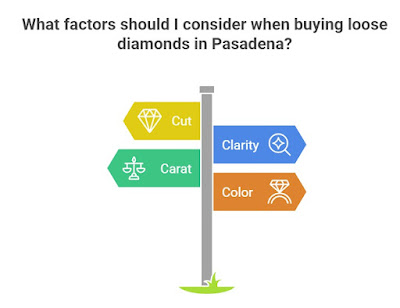What to Look for When Buying Loose Diamonds in Pasadena?
Shopping for gemstones can feel like deciphering a secret language, but learning to spot value soon turns intimidation into excitement.
Loose diamonds in Pasadena come with their own quirks—local market dynamics, a thriving design scene, and a mix of historic and modern jewelers—that reward buyers who do a little homework before opening their wallets.
Start With the “Why” Before the “What”
Begin by clarifying why you want an unset stone. Custom engagement rings dominate Pasadena’s Old Town studios, but investors, collectors, and even jewelry DIY-ers also hunt for stones they can repurpose later. Each goal drives a different checklist: investors obsess over resale liquidity, while custom clients focus on how a stone will look in a particular setting.
Understand the Four Cs—Then Dig Deeper
Everyone knows cut, color, clarity, and carat weight, yet savvy Pasadena buyers go beyond the headline stats.
Cut: The Light Performance Factor
Pasadena’s bright, Mediterranean light exposes poor scintillation faster than the dim showrooms of other cities. Ideal or Excellent-cut grades from GIA or AGS ensure the stone’s facets fire even under midday sun. Ask to view the gem outdoors; most reputable stores in the Playhouse District will accommodate.
Color: Balancing Beauty and Budget
G through I colors can appear icy white once mounted, especially in platinum or white gold. Stepping down one grade often frees 10–15 percent of your budget to spend on superior cut or clarity—attributes you’ll notice every day.
Clarity: Eye-Clean Over Flawless
In practical terms, SI1 stones can look identical to VS1 to the naked eye. Use a jeweler’s loupe on the shop floor and decide whether microscopic feathers really bother you or if that money belongs in a honeymoon fund instead.
Carat: Size Isn’t Linear
A 0.80-carat diamond often costs far less per point than a one-carat stone yet looks almost the same. Pasadena jewelers routinely stock “magic size” bargains—pay attention to millimeter spread, not just weight, if face-up size is your priority.
Certification Is Non-Negotiable
Always insist on a grading report from an internationally recognized lab such as GIA, IGI, or AGS. Independent verification prevents surprises during future appraisals or trade-ins. Think of the certificate as your diamond’s passport: lose it, and resale value plummets.
Natural vs. Lab-Grown: Follow the Market Data
Lab-grown stones have moved from curiosity to mainstream. By 2024 they captured roughly 20 percent of all retail diamond unit sales in the United States forbes.com, and analysts expect global revenue in that segment to triple by 2032 fortunebusinessinsights.com. Natural-diamond prices, meanwhile, have slid 26 percent in just two years, with lab-grown prices falling even faster empower.com. Translation: buyers today wield unprecedented bargaining power.
Comparing Apples to Apples
Loose lab-grown diamonds in Pasadena often come with IGI or GCAL reports that include light-performance maps, making side-by-side comparisons straightforward. Natural stones typically rely on GIA grading; be sure your clerk doesn’t mix nomenclatures when explaining differences.
Inspect Beyond the 4 Cs
Fluorescence: Faint blue fluorescence can improve perceived whiteness under UV-rich California sunlight.
Symmetry and polish: Very Good or Excellent grades ensure crisp facet lines that maximize sparkle.
Depth percentage and table size: Look for balanced proportions—too deep and the stone faces up small; too shallow and brilliance leaks.
Verify Provenance and Ethics
Pasadena’s clientele skews sustainability-minded. Reputable jewelers provide written warranties of conflict-free sourcing under the Kimberley Process. Some also audit carbon footprints or source from Canadian mines with transparent labor standards. Shoppers considering loose grown diamonds in Pasadena appreciate that lab-generated origins dramatically shrink environmental impact.
Test the Retailer, Not Just the Stone
Transparency: A trustworthy shop hands you tweezers, loupe, and grading report without hesitation.
Stone-to-setting service: Many Pasadena retailers design and cast custom mounts on-site. Ask how long they’ll keep your stone and whether work is done in-house or outsourced.
Upgrade policy: Look for trade-in guarantees; they signal confidence in long-term stone quality.
Independent appraisals: Ethical sellers welcome a third-party appraisal; some even recommend local gemologists unaffiliated with their store.
Budget Smart: Hidden Costs and Negotiation Tips
Setting fees: Custom platinum mounts can run 20–40 percent of total project cost.
Taxes: Pasadena’s combined sales-tax rate hovers above nine percent; factor that into “out-the-door” price.
Insurance: Add the replacement value to your homeowner’s or purchase standalone jewelry coverage; annual premiums average one to two percent of appraised value.
Seasonal timing: January and August are historically slower retail months—many jewelers quietly discount inventory before Valentine’s Day and proposal-season rushes.
How to Haggle Gracefully
Bring recent Rapaport price sheets or one credible online quote; most jewelers will at least match if you’re polite and prepared to buy same-day. A friendly Pasadena grad student recently saved twelve percent on a 1.07-carat G-VS2 by showing a screenshot of a similar listing from NYC’s Diamond District—proof that data travels faster than industry lore.
Protect the Purchase: From Loupe to Ring Finger
Laser inscription check: Use a jeweler’s microscope to verify the grading report number etched on the girdle.
Weigh the stone: Reputable jewelers allow you to confirm carat weight on a calibrated scale.
Inspect after setting: Prongs or bezels can hide chips caused during mounting. Examine under magnification before final payment.
Where to Look in Pasadena
Old Town hosts boutiques specializing in estate pieces, while North Lake Avenue offers contemporary design houses with CAD renderings. For buyers who value personal counsel, family-run studios—like CMJ & Diamonds, known for guiding first-time shoppers through certification jargon—combine small-business warmth with big-city inventory.
Red Flags to Walk Away From
Vague language (“near colorless”) without numeric grades.
Pushback against independent appraisals.
“Certificates” issued by in-house staff rather than third-party labs.
Prices that seem too good: a D-color, VVS1 one-carat stone for half market rate is almost certainly clarity-enhanced or misgraded.
The Future Proofs in Your Favor
With natural-diamond prices softening and lab-grown technology advancing, today’s Pasadena shoppers hold unprecedented leverage. Use it wisely: insist on certification, compare natural to lab alternatives, and apply outdoor light tests that reveal true brilliance.





Comments
Post a Comment